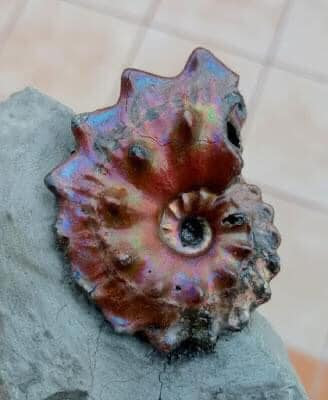Rene was a mountain goat in the field, stalking the hills in his signature red t-shirt. He was tremendously knowledgeable about the natural world and delighted in it. For many years, he was Chair of the White Rock and Surrey Naturalists, while I was Chair of the Vancouver Paleontological Society. Together, we would plan and often co-lead field trips to many of the wonderful fossil outcrops in British Columbia and Washington state.
In 2002, we were planning a very exciting round of field trips. I was offered a fully paid trip to India with Karen Lund to hike to the headwaters of the Ganges, a trip which I was to forgo in favour of a hike up to the outcrops of the Cathedral Escarpment and Burgess Shale and then to yummy Lower Jurassic and Lower Cretaceous, Albian, outcrops accessed only by boat in Haida Gwaii.
Rene and I had talked about "walking in the shoes" of Joseph Whiteaves, the GSC's chief palaeontologist in Ottawa. He published a paper in 1876 describing the Jurassic and Cretaceous faunas of Skidegate Inlet and spent a significant portion of his career working out the fossil fauna of the Burgess Shale. Combining these two sites within the same field season was a fitting homage.
John Fam, Vancouver Paleontological Society (VanPS) and Dan Bowen, Vancouver Island Palaeontological Society (VIPS), did much of the planning for that Haida Gwaii trip, they too being inspired by Whiteaves papers and the work of James Richardson and George Dawson — as a whole, we were giddy with the prospect of the year ahead.
Rene and I had planned to do both, but in the end, I had to give up the hike to Burgess that year and Rene never made it back to join me in Haida Gwaii.
| Rene Savenye |
I take heart that he lived and died doing what he loved most. I got the news a few days later and cried for the loss of a great friend. I am sharing my memory of him with you so that you can remember him, too, and share in the delight and loss of one of the loveliest men to ever walk our planet. His years of teaching, mentoring, encouragement and generosity have helped shape natural science and those who have gone on to make it their passion or career — or happily, both.
Rene's name will not be forgotten to science. His namesake, H. Savenyei, is a lovely fossil halictine bee from Early Eocene deposits near Quilchena, British Columbia — and the first bee body-fossil known from the Okanagan Highlands — and indeed from Canada.
As a school teacher, Rene once taught the, then student, now SFU biology instructor, Rolf Mathewes. Rene passed his scientifically valuable specimen to Mathews, knowing it was important to science. Mathewes brought it to the attention of Bruce Archibald and Michael Engel, who described Rene's bee in the Canadian Journal of Zoology. Their work is a lovely legacy to a wonderful man and a specimen from one of his favourite collecting sites — Quilchena — a small road-cut exposure of the Coldwater beds of the Princeton Group, one of several depositional basins in the Merritt region of south-central British Columbia.
Rene is also remembered in spirit by the British Columbia Paleontological Alliance (BCPA) Rene Savenye Award. It was established in 2003 to honour those who have demonstrated outstanding service to the science of palaeontology or to palaeontological education in British Columbia.
Notable past recipients are a veritable who's who from the Pacific Northwest — Graham Beard of Qualicum in 2005, Charles Helm of Tumbler Ridge in 2011, Pat Trask of Courtenay in 2014, Rod Bartlett in 2016, and Joseph "Joe" Haegert in 2018. I'll share a link to the award below so you can read more at your leisure about Rene and those who bear the award with his name.
About H. Savenyei, (Engel & Archibald, 2003): The type specimen is a fairly well preserved complete adult female preserved with portions of the fore-wings and hind-wings. The specimen is 7.04 millimetres (0.277 in) long with the possibility of alteration in length during fossilization. The sections of the forewing which are preserved are approximately 4.8 millimetres (0.19 in) long and show dark brown to black colouration. The presence of a pygidial plate bordered by setae on the fifth metasomal tergum supports the placement into the Halictidae subfamily Halictinae. Placement into the tribe Halictini is based on the lack of a medial cleft in the fifth tergum.
References:
Archibald, B. & R. W. Mathewes. 2000. “Early Eocene Insects from Quilchena, BC, and their Paleoclimatic Implications.” Canadian Journal of Zoology, Volume 78, Number 6: pp 1441-1462.
Grimaldi, D. 1999. “The Co-radiations of Pollinating Insects and Angiosperms in the Cretaceous.” Annals of the Missouri Botanical Garden. 86: 373-406.
Photo: Halictidae sp.; Archibald and Mathewes 2000: 1453.
Rene Savenye Award: https://bcfossils.ca/rene-savenye-award























.png)








